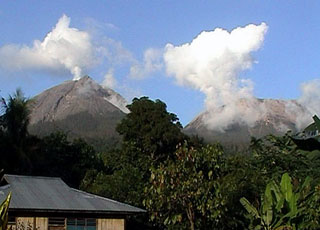Report on Lewotobi (Indonesia) — 10 January-16 January 2024
Smithsonian Institution / US Geological Survey
Weekly Volcanic Activity Report, 10 January-16 January 2024
Managing Editor: Sally Sennert.
Please cite this report as:
Global Volcanism Program, 2024. Report on Lewotobi (Indonesia) (Sennert, S, ed.). Weekly Volcanic Activity Report, 10 January-16 January 2024. Smithsonian Institution and US Geological Survey.
Lewotobi
Indonesia
8.542°S, 122.775°E; summit elev. 1703 m
All times are local (unless otherwise noted)
PVMBG reported that the eruption at Lewotobi’s Laki-laki volcano was ongoing during 10-16 January. Dense white-and-gray or white, gray, and brown ash plumes rose as high as 2 km above the summit and drifted N and NE. Lava flows from the summit crater continued to advance down the N flank and were about 2 km long by 11 January. Rumbling was reported on 13 January. On 14 January as many as four pyroclastic flows traveled up to 1 km down the NE, N, and NNW flanks and lava avalanches traveled 1.5-2 km down the NE flank, according to news articles. Incandescent avalanches of material and accompanying pyroclastic flows traveled as far as 1.5 km N on 15 January. Incandescent avalanches also traveled 2-3 km NE and 1 km NNE. The exclusion zone was increased to 5 km from the Laki-laki Crater and 6 km from the crater on the N and NE flanks during the evening of 16 January. The Alert Level remained at 4 (the highest level on a scale of 1-4).
Geological Summary. The Lewotobi edifice in eastern Flores Island is composed of the two adjacent Lewotobi Laki-laki and Lewotobi Perempuan stratovolcanoes (the "husband and wife"). Their summits are less than 2 km apart along a NW-SE line. The conical Laki-laki to the NW has been frequently active during the 19th and 20th centuries, while the taller and broader Perempuan has had observed eruptions in 1921 and 1935. Small lava domes have grown during the 20th century in both of the summit craters, which are open to the north. A prominent cone, Iliwokar, occurs on the E flank of Perampuan.
Sources: Pusat Vulkanologi dan Mitigasi Bencana Geologi (PVMBG, also known as CVGHM), Antara News, Antara News, Antara News, Antara News, Antara News

